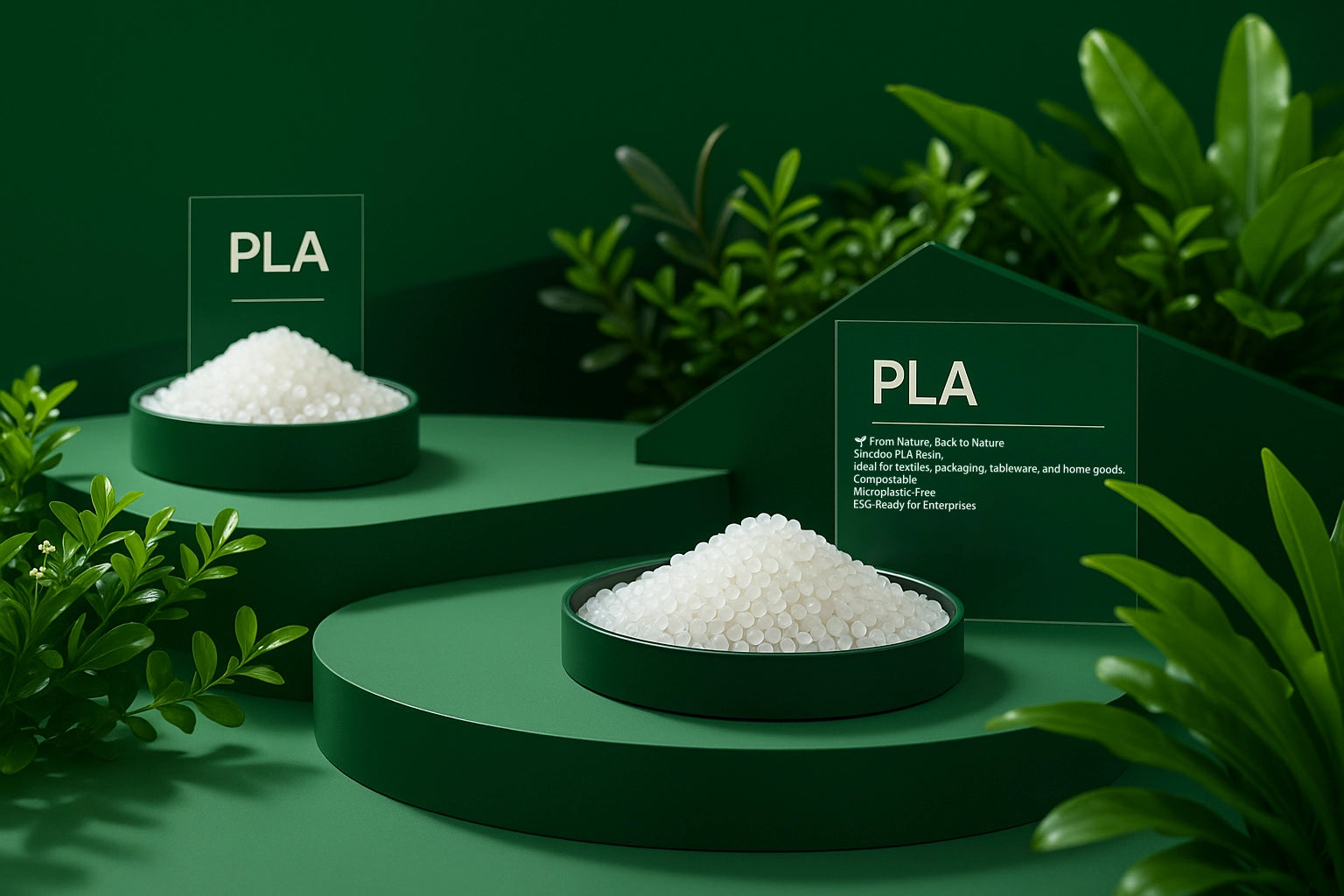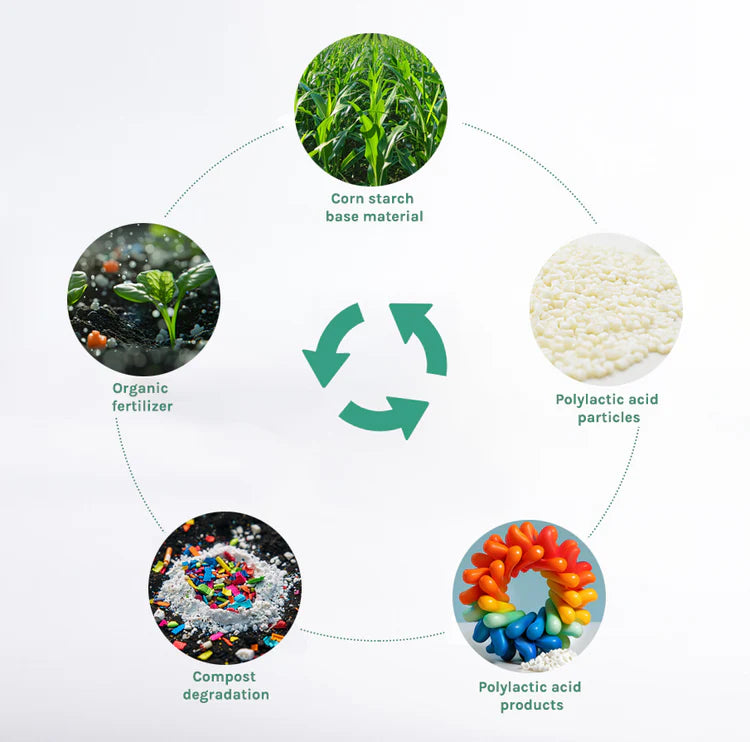
SincdooのPLAについて
PLAバイオプラスチックは、より健康な地球のために、より環境に優しく持続可能な材料を開発する上での前進を示しています。
PLA offers an effective material solution for reducing environmental pollution and advancing sustainable development through its environmental friendliness, renewable sources, and application versatility.
Sincdoo Biotech Co., Ltd. はZBグループの子会社で、ポリ乳酸(PLA)製品の研究と応用を専門としています。ZBグループは中国の大手アパレル製造会社で、スーツ、スポーツウェア、カジュアルウェア、アウターウェア、コート、下着、子供服、ホームテキスタイルなど、さまざまな分野の数多くの有名ブランドにOEMサービスを提供しています。さらに、ZBグループは特定の用途に特化した特殊生地も開発しています。ZBグループの子会社として、Sincdooは持続可能で生分解性のある製品の開発と応用に取り組んでいます。ZBグループの強力なデザインと供給能力を活用し、衣料用PLA繊維、PLA日用品、PLA医療用品の分野で革新的なソリューションと高品質の製品を提供しています。
原材料の調達:
市場に出回っているほとんどの生分解性材料は主要作物から派生していますが、Sincdooはより高品質で責任あるPLA用原材料を選定することに専念しています。われわれは、食糧供給に最小限の影響を与える原材料の調達を優先しており、これにはわら、サトウキビ、および少量の遺伝子組み換えトウモロコシが含まれます。これらはPLAを生産するための発酵に使用されます。これらの材料は通常、農業副産物または高収量作物で、世界の食料供給に大きな影響を与えません。さらに、発酵の副産物は他の製品の生産に使用することができます。この原材料調達戦略は、食料資源の競争を減少させるだけでなく、持続可能な開発の原則にも従い、環境保護と資源効率を促進します。Sincdooは、PLA製品の普及を促進しながら、世界の食糧安全と生態バランスに貢献することを目指しています。
技術革新と研究開発能力:
改良PLA顆粒製品:国際的に有名なPLA樹脂会社であるNatureWorks、Total Energies、Haizheng Bio、Fengyuanと協力し、特定の製品特性に基づいて異なる用途向けに改良PLA原材料をカスタマイズしています。
PLA繊維:短繊維と長繊維の両方を提供しており、生産ラインのアップグレードと織り技術の改善を通じて、高品質で多機能性のある生地を生産しています。100%PLA生地を提供し、顧客の要望に応じて、異なる使用環境に適した混紡生地も提供しています。例えば、ポリエステル繊維をPLA繊維に置き換えることで、石油ベースの製品の使用を大幅に削減しています。PLAとウールの混紡生地は安定した性能を確保しながら、綿と石油ベースの材料の使用を避け、使用するウールの量を減らすことで、最終的に動物福祉と環境保護を改善します。さらに、Sincdooは、さまざまな地域の顧客の需要に応じて、有機綿とRWS認証ウールから作られた混紡生地も提供しています。PLA生地と完成した衣類製品の生産に関するOEMソリューションで顧客をサポートしています。
PLA日用品: 日常必需品(ナイフ、フォーク、スプーン、カップなど)や3Dプリント材料を含むカスタマイズされたPLA製品を提供しており、コーヒーかすや米ぬかを加えることで独特の外観を作り出し、環境効果を高めることができます。
PLA医療分野: 病院向けの使い捨てPLA製品、たとえば医療シーツや白衣を提供しています。
自動車および建築材料: PLA材料を取り入れたさまざまなエコフレンドリー製品を開発しており、環境汚染を最小限に抑え、関連企業のカーボン排出を削減することを目指しています。
Sincdooの認証とチーム: DIN、TÜV、BPIなど、さまざまな認証を提供しています。Sincdooには、専門的な研究開発およびデザインチームがあり、著名な研究機関や大学と協力して高品質の製品を共同で開発しています。デザイナーは世界的に認められたアパレル会社出身であり、顧客とのパートナーシップにおいてカスタマイズされた高品質の製品開発ソリューションを提供する能力があります。
SincdooのPLAリサイクルソリューション: 地域の政策の違いにより、すべての地域で生物的な堆肥化と分解が行われるわけではありません。そのため、いくつかのPLAリサイクルソリューションを提供しています:
堆肥化: 堆肥化施設がある地域では、顧客は直接PLA製品を堆肥化して分解することができます。
リサイクルと再利用: 中国のリサイクラーと協力してPLA製品をリサイクルし、それを粉砕して内装および外装装飾に使用される床材に押し出します。
焼却: 電力不足の地域では、PLA製品は完全に燃焼して水と二酸化炭素を生成し、化学製品に比べて環境汚染を大幅に減少させます。
酵素分解: SincdooはXIKe Enzymeと提携して酵素調整剤を開発し、PLAの分解を加速し、生分解性分野でのPLAの利点をさらに示すことを目指しています。
*研究により、自然環境でゆっくりと分解するPLAでも、微小プラスチックの危険は生じないことが示されています。
BusinessWireからの新しいメタスタディのハイライト:加水分解が環境中での持続性PLAマイクロプラスチックの形成を防ぐ
-
Environmental Friendliness
PLA is biodegradable, meaning it can decompose into water and carbon dioxide in industrial composting facilities, significantly reducing environmental impact. Compared to traditional petroleum-based plastics, the production and decomposition of PLA emit fewer greenhouse gases, contributing to mitigating climate change effects. Moreover, PLA's degradation process does not produce harmful microplastics, crucial for protecting aquatic and soil environments.
-
再生可能な資源
PLAは、トウモロコシ澱粉、サトウキビ、その他の作物などの再生可能な資源から作られています。これは、有限な化石燃料資源から生産される従来のプラスチックとは対照的です。再生可能な資源を利用することは、化石燃料への依存を減らすだけでなく、持続可能な農業を促進し、農業副産物に新しい価値を創造することにもつながります。
-
用途の多様性
PLAの優れた物理的および化学的特性により、包装材料、使い捨て食器、繊維、医療用品、3Dプリンティング材料など、さまざまな分野で広く使用されています。この多用途性により、PLAは異なる業界のエコフレンドリーな材料の需要に応える高度に柔軟な材料となっています。PLAの多様な用途は、環境の持続可能性を促進し、グリーン経済の成長を支援する上での大きな可能性を示しています。


ポリ乳酸(PLA)の持続可能なライフサイクル
ポリ乳酸(PLA)は、完全な循環型ライフサイクルを実現する革新的な持続可能素材です。PLAは藁(わら)、コーンスターチ、サトウキビなどの再生可能資源から作られ、多様な製品へと加工されます。使用後の製品はコンポスト(堆肥化)によって自然に分解され、有機肥料、水、二酸化炭素へと戻ります。この環境に優しいサイクルにより、廃棄物を削減し、環境保護に貢献し、よりグリーンで持続可能な未来を実現します。
Common Questions About Polylactic Acid (PLA)
Why is PLA considered environmentally friendly?
PLA is deemed environmentally friendly because it is derived from renewable resources like corn starch or sugarcane, which absorb CO2 during their growth, reducing greenhouse gas emissions. Moreover, PLA can fully biodegrade under proper conditions, diminishing long-term environmental pollution.
If PLA is inadvertently discarded in the environment, what is its impact on health and the environment?
Compared to traditional plastics, PLA, due to its biodegradable nature, will not persist in the environment and generate microplastics, thereby lowering potential harm to both the environment and human health.
How is PLA's biodegradability achieved?
PLA's biodegradability is achieved through the breaking of specific molecular chains under the high temperature and humidity conditions of industrial composting environments, eventually decomposing into carbon dioxide and water. This requires specific composting facilities.
What are the advantages of PLA in applications?
PLA's application advantages lie in its versatility and customizability. It can be used to manufacture packaging materials, disposable tableware, clothing products, durable goods, biomedical products, and even automotive interior products. It can also be modified by adding different additives to enhance its heat resistance or alter its biodegradation rate, meeting the needs of various fields.
How is PLA different from other bioplastics?
Compared to other bioplastics, PLA typically shows better performance in biodegradability, source material, and the environmental impact of its production process. PLA's raw materials are primarily agricultural crops, giving it a clear advantage in reducing dependence on fossil fuels.
Compared to traditional plastics, what are the safety and health advantages of using Polylactic Acid (PLA) products?
PLA products offer several significant advantages in terms of safety and health, especially when used for food packaging and containers and infant products:
1- No Harmful Substance Release: Made from natural renewable resources, PLA does not contain harmful Bisphenol A (BPA) or other chemicals that could negatively impact human health. In contrast, some traditional plastics may release harmful substances when in contact with food or exposed to heat.
2- Biocompatibility: Due to its bio-based nature, PLA is more body-friendly and widely used in the medical field, such as biodegradable sutures and drug delivery systems, indicating PLA is considered to have a lower toxicity risk to humans.
3- Reduced Chronic Exposure Risk**: Since PLA is biodegradable, using it reduces the accumulation of microplastics in the environment, thereby lessening people's indirect exposure to microplastics through the food chain. Long-term exposure to microplastics is believed to potentially have adverse health effects. Especially in baby toys, due to babies' chewing habits, it can prevent babies from ingesting plastics and causing harm to the body.
4- Safer Waste Disposal**: The biodegradable nature of PLA products means they can fully decompose under appropriate treatment conditions, reducing the risk of harmful chemicals being released into the environment during waste disposal processes.
Common questions about Polylactic Acid products.
Application scenarios for Sincdoo Polylactic Acid (PLA) fibers
Sincdoo Polylactic Acid (PLA) fiber, as an eco-friendly and health-conscious material, offers a broad spectrum of applications, extending beyond mere filling materials to encompass the textile and apparel industry. As a filler, PLA fibers serve as an ideal alternative to traditional synthetic fillers, enhancing product healthiness and sustainability, making them suitable for use in filling materials for baby toys, sofas, and more. In the realm of clothing, PLA fibers stand out due to their unique advantages such as skin-friendliness, antibacterial properties, environmental safety, non-toxicity, stain resistance, water resistance, lightness, and comfort. These characteristics not only meet modern consumers' demands for health-conscious and eco-friendly apparel but also drive the clothing industry towards a more sustainable development path.
Application scenarios and product advantages of Sincdoo's durable Polylactic Acid (PLA) products.
Tableware: Sincdoo's PLA tableware is not only eco-friendly and biodegradable but also boasts excellent heat resistance and strength, making it suitable for both disposable and reusable dining services. It can also be applied in the field of infant and toddler utensils, replacing most plastic products.
Children's Hard Toys: The non-toxic nature of PLA material makes it an ideal choice for manufacturing children's toys, ensuring safety while offering durability and strength to withstand daily wear and tear.
Cosmetic Packaging Boxes: In the cosmetic packaging domain, PLA not only provides an eco-friendly packaging solution but also enhances brand competitiveness through its excellent appearance and customizability, offering new possibilities for brand elevation.
3D Printing Materials: As a material for 3D printing, PLA is widely recognized and appreciated by hobbyists and professionals alike for its environmental friendliness, printer compatibility, aesthetics, mechanical properties, health safety, and cost-effectiveness.
Sincdoo's durable Polylactic Acid (PLA) products not only meet the market demand for eco-friendly, healthy, and high-quality materials but also provide robust support for businesses to explore new market opportunities and enhance brand value.
The application of Polylactic Acid in the medical supplies sector
The application of Polylactic Acid (PLA) in the medical supplies sector showcases its unique advantages as a biocompatible and biodegradable material, including: absorbable sutures, drug delivery systems, stents and implants, tissue engineering, 3D printed customized medical devices, masks, disposable medical pads, and more. The wide use of PLA in medical supplies is not only due to its biodegradability and biocompatibility but also because of its potential for customization, offering patients more personalized and effective treatment options. These applications demonstrate the significant role of PLA in promoting sustainable development and innovation within the medical field.
The application of Polylactic Acid (PLA) in automotive interior
The use of Polylactic Acid (PLA) in automotive interior accessories represents a significant step towards sustainable and eco-friendly automotive manufacturing. Our current range of PLA-based products includes durable floor mats designed for long-lasting protection, ergonomically designed headrests for enhanced comfort, and versatile mobile phone holders for added convenience. These products not only showcase the material's versatility and durability but also its commitment to reducing environmental impact in the automotive industry.
The recycling of Polylactic Acid (PLA)
- Industrial Composting: PLA is biodegradable but requires specific industrial composting facilities with high temperatures and appropriate humidity levels for effective decomposition. This method can completely break down PLA into water and carbon dioxide.
- Chemical Recycling: Through chemical recycling processes, PLA can be depolymerized into its original monomers or other useful chemicals, which can then be reused in new polymerization reactions to create new PLA products.
- Mechanical Recycling: Although not as common as with traditional plastics like PET, mechanical recycling can also be applied to PLA. This involves physically grinding PLA products into small particles, then cleaning, melting, and reprocessing them into new products.
- Energy Recovery: Since PLA is made from organic materials, it can be incinerated to recover energy. While not the most environmentally friendly method of recycling, it can convert PLA into energy rather than landfilling in the absence of other recycling options.
